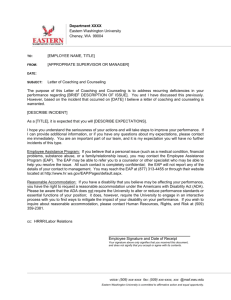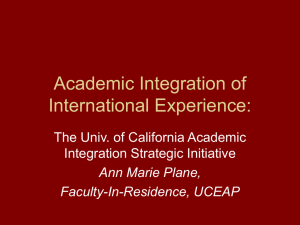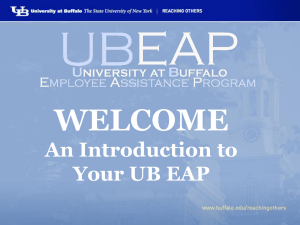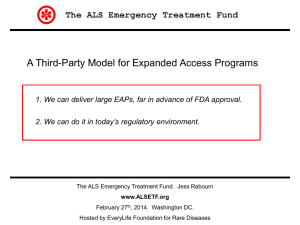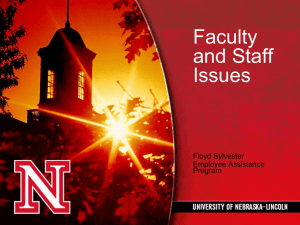Extensive and Intensive Reading in an EAP Setting
advertisement
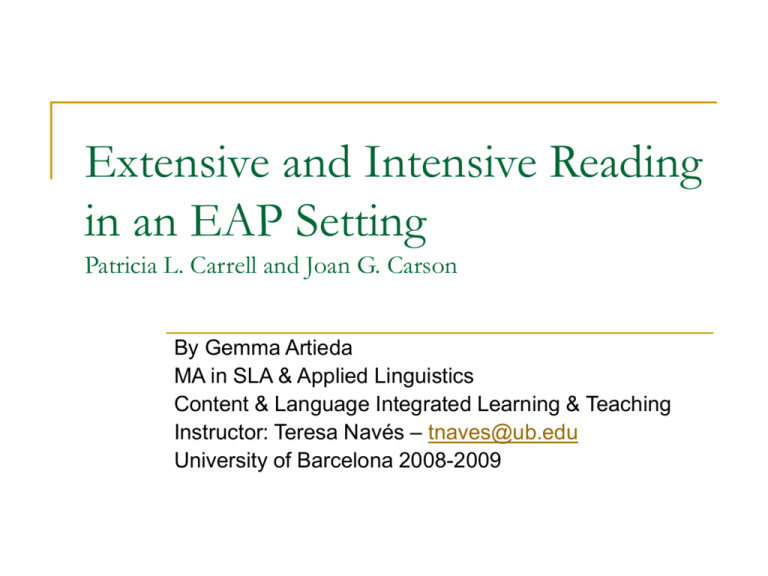
Extensive and Intensive Reading in an EAP Setting Patricia L. Carrell and Joan G. Carson By Gemma Artieda MA in SLA & Applied Linguistics Content & Language Integrated Learning & Teaching Instructor: Teresa Navés – tnaves@ub.edu University of Barcelona 2008-2009 Abstract The article argues for: The need for intensive and extensive reading in English for Academic Purposes (EAP) reading curriculum. A principled curricular approach to combining both is through Task-Based Language Teaching (TBLT). Introduction: the Meaning of Literacy in EAP Settings Academic purposes are different from any other. As Anderson et al (1990:11) noted, “there is not one single image of academic literacy”. Reading & writing activities are rather described as “academic literacies” by Chiseri-Strater (1991). Introduction: the Meaning of Literacy in EAP Settings How do we maximize then the instructional effectiveness of EAP reading programs? Research in L1 suggests that underprepared students benefit most from instruction in reading & writing tasks that resemble the actual literacy demands of university work (Feathers&Smith 1983; Nist&Kirby 91986). Therefore, this seems to indicate that work needs to be done focusing on teaching literacy skills that are transferable to academic contexts. Research so far supports this approach. Learning to Read by Receiving Strategy Instruction: the Case for Intensive Reading in an EAP Setting The importance of a reading strategic repertoire has led pedagogy to emphasize instruction as the means for L2 students to obtain the necessary reading strategies for EAP settings. Research has shown the important role played by various strategies in successful and unsuccessful L2 learning. In 1985 Carrel (1985) demonstrated the efficacy of teaching a text structure strategy for expository texts. Hamp-Lyong (1985) also showed the positive effects of this approach, and Sarig & Folman (1987) conducted a successful coherence training study. Carrell, Pharis and Liberto (1989) reported two meta cognitively-based strategy training techniques, with differential effects on students with different learning styles. Kern (1989), Raymond (1993), and Talbot (1996) have further researched and demonstrated the validity of this aproach. Learning to Read by Receiving Strategy Instruction: the Case for Intensive Reading in an EAP Setting An important component of reading strategy training has been its focus on metacognition. See Anderson (1991:19): “Successful L2 reading comprehension is not simply a matter of knowing what strategy to use, but the reader must also know how to use it successfully and orchestrate its use with other strategies”. Carrel (1996) then identified the range of metacognitive elements used: declarative (information that we have and that we know we have), procedural (how to- knowledge underlying automatic performance) and conditional (knowing when to use or not to use a skill). All students in these intervention studies were at university level. Learning to Read by Reading: the Case for Extensive Reading in an EAP Context There has been a resurgence of interest in extensive reading as part of L2 language development programs. Krashen (1989, 1993) continues to call for a major role for free voluntary reading in ESL acquisition. Challenges: Involves rapid reading of large quantities of material Focus is on meaning rather than on structures or form Involves a variety of skills or strategies Learning to Read by Reading: the Case for Extensive Reading in an EAP Context At the Reading Research Colloquium of the 1995 TESOL Convention, two major figures articulated the need for extensive reading while acknowledging the challenges: Swaffar (1995) reported enthusiastic responses from students exposed to narrow reading as a form of extensive reading, and suggests that ER can “address the current gulf between learning a language and using a language to learn”. Learning to Read by Reading: the Case for Extensive Reading in an EAP Context Grabe (1995) reviewed what ER can do for effective reading: Develops automatic word recognition, and a large recognition vocabulary. Builds student motivation, students get “hooked”. Has a positive influence on students’ general background knowledge. Has a positive influence on reading comprehension proficiency. Helps students become strategic readers, as well as developing their ability to “read to learn”. It is a key means for students to continue learning an L2 on their own when after they complete instruction. Learning to Read by Reading: the Case for Extensive Reading in an EAP Context He also identified several challenges for ER to become the focus of instruction: 1. 2. 3. 4. The assumption that reading can easily be done at home, without teacher’s help. The need to find lots of interesting material. The need to accommodate different students’ backgrounds. The vagueness of the definition of extensive reading. Learning to Read by Reading: the Case for Extensive Reading in an EAP Context Day & Bamford are publishing a book: Developing Lifelong Readers: Extensive Reading in the FL Clasroom, and they struggle with the definition of ER too: “reading in quantity” (Longman Dictionary of Language Teaching and Applied Linguistics) “to gain an understanding of what is read” (id) Also “a way of teaching reading and the foreign language itself” (Day&Bamford). The Need for Both Intensive and Extensive Reading in an EAP Setting Nutall (1982) reminded us that “intensive and extensive reading are complementary and both are necessary”. According to Nutall, these are not two contrasting ways of reading, but that there are an infinitive variety of interrelated and overlapping techniques. She suggests how an extensive reading program might be organized to turn the vicyous cycle of the weak reader into the vicious cycle of the good reader. Combining Intensive and Extensive Reading: A Curricular Approach One response has been Content-Based Instruction (CBI): in this model it is implied the use of a single subject-specific text that is by nature appropriate for both intensive and extensive reading. Limitations: It has been used more with the K-12 population. Combining Intensive and Extensive Reading: A Curricular Approach Why not use it then in post-secondary settings? Criteria for content selection are problematic: an EAP program content is not easy to specify, and not all will be shared in an EAP classroom. The CBI goal of content mastery will be difficult to transmit to an EAP student, since his/her needs are so variable. CBI does not provide a principled basis for deciding on course focus in case where content mastery is unnecessary or inappropriate. Combining Intensive and Extensive Reading: A Curricular Approach The answer can be in Task-Based Language Teaching (TBLT): As in CBI, it is based on the idea that communicative purposes are essential in real language learning. But the organizing principle is task, not content. Language is acquired on the completion of a task. Combining Intensive and Extensive Reading: A Curricular Approach Why will TBLT work in EAP settings? Academic tasks involve evaluated products, such as exams, reports, papers and quizzes. By focusing TBLT on evaluated products, the student acquires all types of relevant subtasks and study skills. EAP students recognize the evaluated products as real academic demands: tasks have validity, and also transferability of skills and strategies. Content is secondary, becoming the context in which the student manages tasks and subtasks. Because the tasks are tailored to fit the learner’s needs, it does maintain a clear connection with genuine language in genuine communicative interactions. Combining Intensive and Extensive Reading: A Curricular Approach What is needed then in this approach is extensive reading of academic text in any content area, combined with strategy instruction for dealing with specific academic tasks. Conclusion TBLT is a principled way of integrating intensive reading and strategy instruction with appropriate extensive reading in postsecondary EAP settings. Both intensive and extensive reading will provide students to manage the reading demands of actual academic classes.


